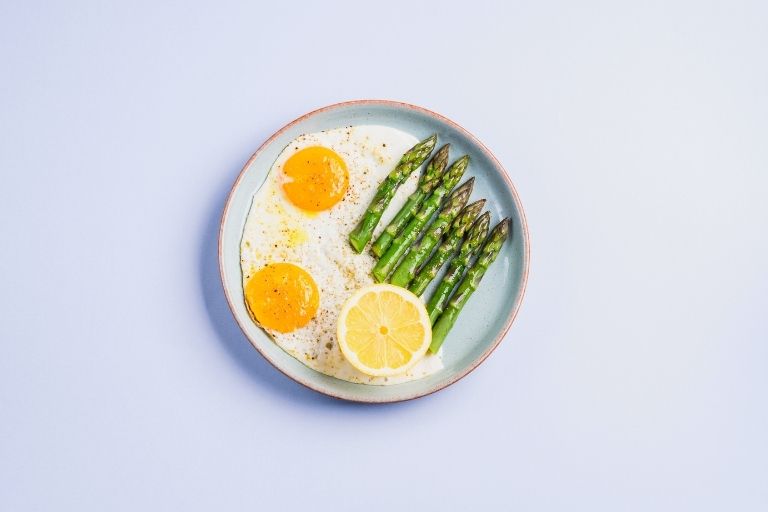The standard version of the keto diet allows you to eat only 50 grams of carbs per day. While this benefits most people, especially those who need to control their blood sugar, some individuals on keto may need extra carbs for a purpose. This is where the cyclical ketogenic diet comes in.
In this guide, we’ll define cyclical keto, how it differs from carb cycling, reasons to use it, getting started, and possible disadvantages you should know.
What is the Cyclical Keto Diet?
The cyclical ketogenic diet or CKD is when a person limits their carbs 5-6 days a week — as in a standard keto diet — and then increases their carb intake (a.k.a. “carb loading” or “carb refeeding”) on the remaining 1-2 days. This benefits athletes, avid exercisers, and people who need help pushing past a keto plateau.
During these refeed days, most of your calories should come from carbs while fats should only be minimal. Think about swapping out fat for carbs as your energy source.
So, your cyclical ketogenic diet macros would be:
- Carb: 70% of your total calories
- Fat: 10% of your total calories
- Protein: 20% of your total calories
On these higher carb days, your body would normally go out of ketosis since carbs now replenish your glycogen stores. However, this is only temporary, because you re-enter a ketotic state when you bring down your carbs as you resume standard keto.
Cyclical Keto vs. Carb Cycling
Carb cycling and cyclical keto are quite alike in that both strategies involve upping your carbs on certain days. However, unlike cyclical keto, carb cycling doesn’t necessarily follow a strict keto diet (50 grams per day).
A person can do carb cycling even when they’re following only a low-carb diet (150 grams per day) on most days and then bring those carbs higher for their health, fitness, and training goals. So, someone who’s carb cycling doesn’t mean they’re on a keto diet.
In other words, both cyclical keto and carb cycling aim for the same goals. Furthermore, keep in mind that eating carbs, in these cases, is an intentional act — which means that you still need to have them in the right amounts and make healthy choices. Nutrient-dense, complex carbohydrates are the best options such as sweet potatoes, whole wheat bread, carrots, turnips, and beans.
Potential Benefits of Cyclical Keto
Not exactly sure how the cyclical ketogenic diet can help? Here are its possible advantages for you.
Promotes muscle growth
While the keto diet reduces insulin which is great for your health, insulin is considered an anabolic hormone. Insulin increases the transport of glucose and amino acids into your skeletal muscles, making them grow. Furthermore, insulin decreases protein breakdown in muscle (1).
If you’re looking to optimize muscle growth while on keto, then perhaps you might want to consider cyclical keto.
Improves strength and athletic performance
Training at higher intensities may compel a person to consume extra amounts of carbohydrates to support their performance (2). One study published at The Journal of Physiology showed that training with carbs was linked to improved race outcomes in endurance athletes (3).
Try to observe your performance at the gym. If you believe that it has decreased while on low-carb for several weeks now, experiment with 1-2 higher carb days and see how it goes.
May help increase your nutrient intake
Meeting your body’s nutritional needs can be done by eating a variety of foods. Sticking to a well-formulated keto diet won’t put you at risk of a deficiency; however, refeeding with carbs as an athlete can also help improve your nutrition.
Complex carbohydrates like sweet potatoes, beans, carrots, and quinoa contain vitamin C, vitamin E, B vitamins, potassium, phosphorus, and folate.
Beat a weight loss plateau
When done correctly, the cyclical ketogenic diet can become an effective weight loss tool. Here’s how that works: Carbs increase insulin, which also increases leptin production in fat cells (4). Leptin is responsible for decreasing your appetite, thereby aiding with weight control.
As an active person who’s on a very low-carb lifestyle for a long time now, you might find yourself having an increased appetite often. That’s because your insulin levels are low (which is a good thing), but your leptin levels have also decreased. This tells you that a carb-up could be beneficial.
Helps you stick to keto long-term
Severe restriction can often take an emotional toll on you. Not everyone considers the keto diet restrictive — in fact, some find it liberating and enjoyable, especially because of its positive effects on health and well-being. But keep in mind that everyone’s perspective is different.
For certain people, incorporating carbs strategically takes off that pressure and helps them maintain a keto diet for months, even years.
How to Start the Cyclical Keto Diet
Anyone who’s ready to do cyclical keto should follow these steps.
1. Get keto adapted first
Note that cyclical keto is not a diet strategy for beginners. It’s best used by people who have followed the standard keto diet consistently. Do it for at least 4 weeks after entering ketosis before experimenting with higher carb days.
2. Do the standard keto diet 5-6 days a week (Monday-Friday)
Cyclical keto is to be done 1-2 days a week, which means that most days you’ll be sticking to a standard keto and limiting your carbs to only 50 grams. For a lot of people, standard keto during weekdays would be easier since these are busier days. You’re more preoccupied with work and less likely to think about food.
Keep your diet as clean as possible by prioritizing whole keto foods like eggs, a wide variety of meats, poultry, seafood, and non-starchy vegetables. Use this keto grocery shopping list for specific food ideas.
3. Eat more carbs on the remaining 1-2 days (Saturday and Sunday)
The next step involves increasing your carbs. You could do this on weekends. I’d like to think of this as an opportunity to enjoy days off with your loved ones if they’re non-keto. But never go off the rails by eating just anything you like! Processed and sugar-laden carbs are not the best choices here.
A healthy selection includes complex carbohydrates. Think about sweet potatoes, beans, quinoa, barley, carrots, beans, kiwi, and apples. Planning your meals ahead of time will increase your chances of success.
To repeat what was mentioned earlier in this guide: Carbs will comprise 70% of your calories during these days, protein is 20%, while fat is only 10%. Since everyone’s daily calories are unique, you’ll have to calculate this to get your right amount of carbs, protein, and fat.
Another very helpful tip: Get moving after a high-carb meal. Exercising after eating keeps your blood sugar levels under control. Take a brisk walk or another light cardio.
4. Get back into ketosis
When it’s time to return to ketosis, consider intermittent fasting, increasing your workout duration, on top of drastically reducing your carbs. You should be able to enter ketosis within 2 days of doing these.
5. Track your results
See if cyclical keto is working for you. Use a food and workout log to jot down your meals and how they’re impacting your actual performance at the gym. Are you building muscle? Getting stronger? Are you able to finish your session without feeling fatigued? Did you lose that excess weight?
A 2018 study showed that routine tracking increases your knowledge and allows you to manage your health better (5).
Potential Downsides of Cyclical Keto
Carbohydrate refeeds could do more harm than good if you’re not careful. Not being strategic about your carb intake (eating processed carbs and excessive amounts of carbs) will lead to possible weight gain. To prevent this from happening, it’s vital to track your carb macro, stick to it, and maintain an active lifestyle.
Another potential downside would be an increase in food cravings. Though not all, some people find that eating carbs causes them to want more — specifically carbs with high glycemic index (donuts, bread, cereals). Being fully aware of yourself gives you the ability to practice self-control.
The Bottom Line
The cyclical ketogenic diet is a useful tool for athletes and those living an active lifestyle in general. If you’re still overweight or obese at this point, adhering to a standard keto diet is best. But if you’re lean, looking to build muscle, need a performance boost, and assistance to overcome a fitness plateau, then cyclical keto is worth a try.
Do not use cyclical keto as an excuse to overeat unhealthy foods. Sugar-laden processed foods like ice cream, donuts, and chocolates will only increase your risk of metabolic disease.
After carbing up with natural options, be sure to re-enter ketosis. I hope that you can reach your goals faster with this strategy. Document your results so that you know you’re on the right track.
References:
- Dimitriadis G, Mitrou P, Lambadiari V et al. Insulin effects in muscle and adipose tissue. 2011 August
- Bytomski J. Fueling for Performance. 2017 November 27
- Burke L, Ross M, Garvican‐Lewis L et al. Low carbohydrate, high fat diet impairs exercise economy and negates the performance benefit from intensified training in elite race walkers. 2017 February 14
- Wabitsch M, Jensen P, Blum W et al. Insulin and cortisol promote leptin production in cultured human fat cells. 1996 October
- Figueiredo M, Caldeira C, Chen Y et al. Routine self-tracking of health: reasons, facilitating factors, and the potential impact on health management practices. 2018 April 16



